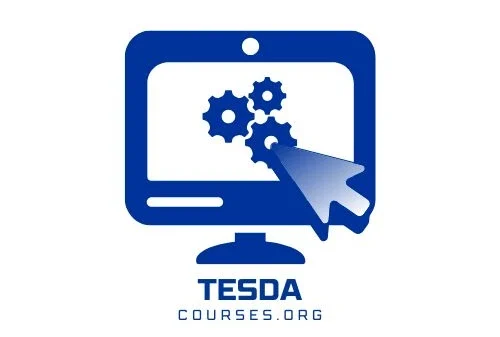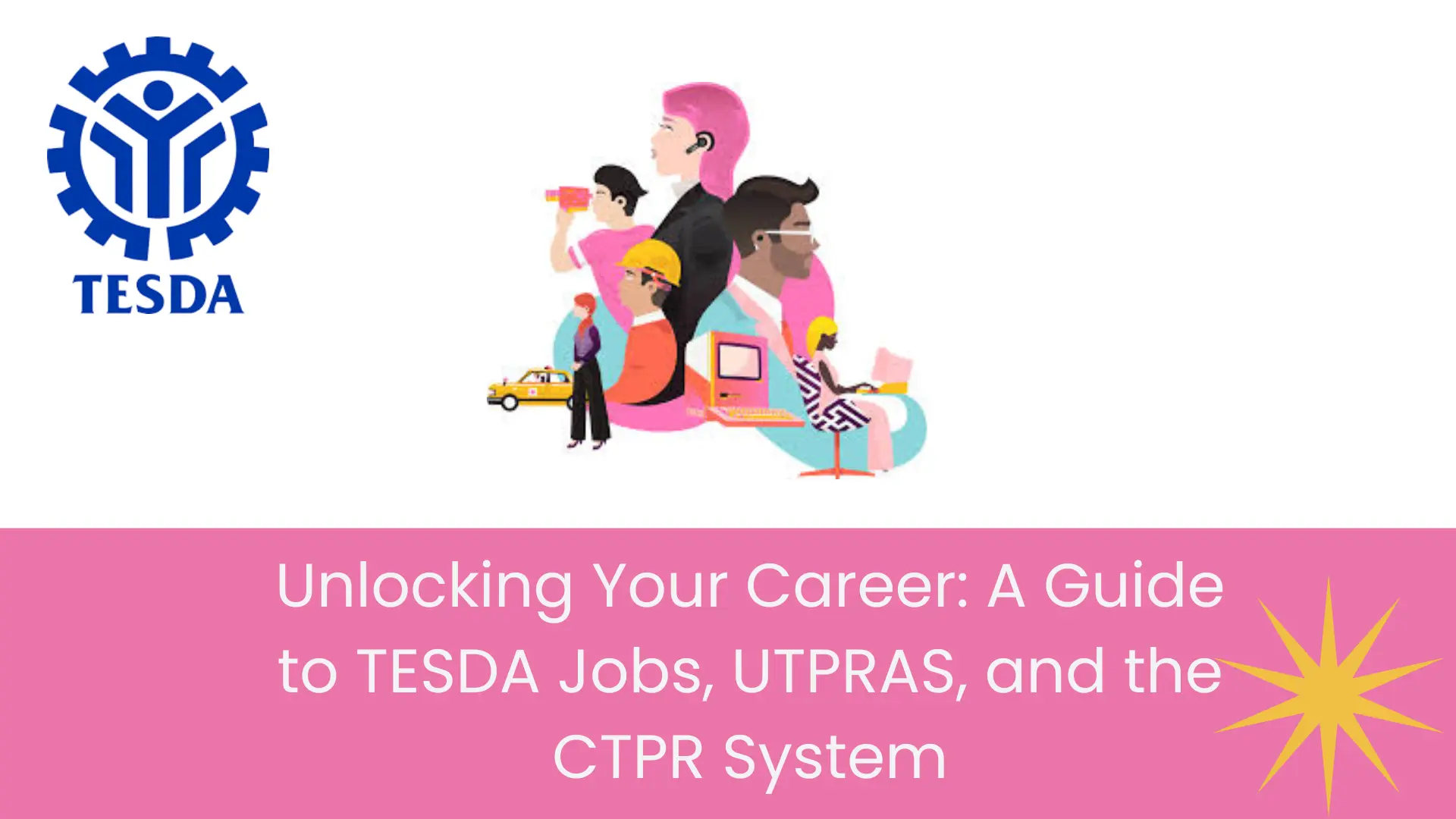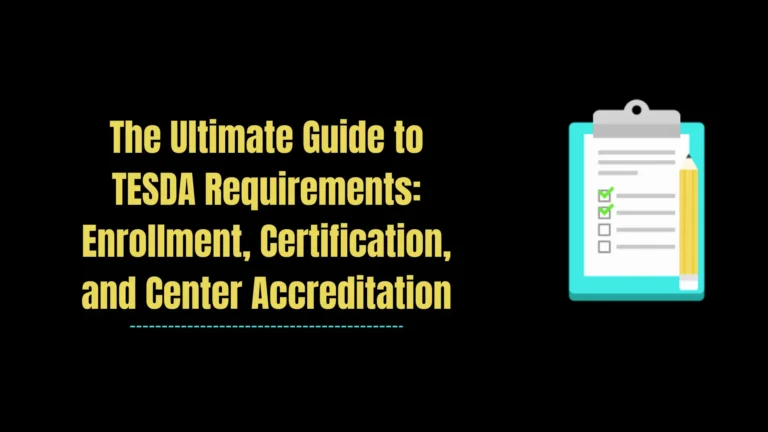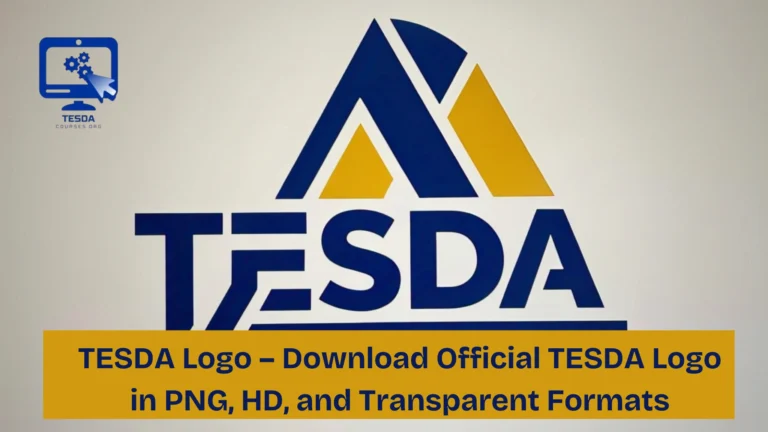Unlocking Your Career: A Guide to TESDA Jobs, UTPRAS, and the CTPR System
Introduction: From Certification to Career – The TESDA Ecosystem of Employment
Earning a National Certificate (NC) or Certificate of Competency (COC) from the Technical Education and Skills Development Authority (TESDA) is a significant achievement. It validates your skills, boosts your confidence, and signifies that you are job-ready. However, the ultimate goal for most graduates is to translate that certification into meaningful, sustainable, and well-compensated employment. The journey from the training center to the workplace is a critical phase, and TESDA has developed sophisticated systems to bridge this gap.
This journey is governed by two pivotal, yet often misunderstood, acronyms: UTPRAS and CTPR. Understanding the UTPRAS meaning and the role of the CTPR TESDA system is crucial for any graduate navigating the job market. These frameworks are not just bureaucratic terms; they are the backbone of TESDA’s strategy to ensure that its training programs are directly aligned with the needs of industry, thereby guaranteeing a high employment rate for its scholars.
This definitive pillar guide serves as your master blueprint for building a career after TESDA. We will demystify the UTPRAS meaning, explore the function of the CTPR, and illuminate how these systems work in tandem to connect you with employers. We will delve into the highest-paying TESDA jobs and careers both in the Philippines and overseas, identify the most in-demand skills, and provide a practical roadmap for leveraging your certification.
Beyond theory, we will provide actionable strategies for job hunting, from utilizing TESDA’s employment facilitation services to networking effectively. Whether you aim to work as a skilled professional in a multinational company, become an overseas Filipino worker (OFW), or start your own entrepreneurial venture, this guide will provide the knowledge and tools to successfully launch your career.
The Foundation: How TESDA Training is Designed for Employment
TESDA’s philosophy is fundamentally employment-driven. Unlike some educational models that focus purely on theory, TESDA’s competency-based training (CBT) system is built from the ground up to meet the actual demands of the labor market. This alignment is achieved through a continuous feedback loop between industry and the training sector, primarily facilitated by the UTPRAS and CTPR systems.
Decoding the System: UTPRAS Meaning and Its Critical Role
UTPRAS is one of the most important concepts for understanding how TESDA ensures the relevance of its programs.
What is UTPRAS?
UTPRAS stands for Unified TVET Program Registration and Accreditation System. It is the centralized mechanism through which all Technical-Vocational Education and Training (TVET) programs offered by both public and private institutions are registered and accredited by TESDA.
Why is Understanding UTPRAS Meaning Important for Your Career?
For a graduate, the UTPRAS meaning translates directly to quality assurance and market relevance. Here’s how:
- Standardization: UTPRAS ensures that every training program registered under it complies with the specific Training Regulations (TR) set by TESDA. This means that a Cookery NC II program in Manila teaches the exact same competencies and standards as a Cookery NC II program in Cebu. This national standardization is what gives your NC its credibility and universal recognition among employers.
- Industry Alignment: The Training Regulations (TRs) that form the basis of UTPRAS are not created in a vacuum. They are developed in close consultation with industry experts, employers, and industry boards. This ensures that the skills you learn are the exact skills that employers are actively seeking.
- Accreditation Benchmark: When an institution’s program is UTPRAS-accredited, it means TESDA has verified that the school has the required facilities, equipment, and qualified trainers to deliver the program effectively. This protects you from enrolling in substandard or “diploma mill” type courses.
In essence, the UTPRAS meaning is synonymous with quality, standardization, and employability. When you choose a UTPRAS-registered program, you are investing your time in a curriculum that is designed to make you highly employable.
The Engine of Employment: The CTPR TESDA System
If UTPRAS ensures the quality of training, the CTPR is the system that tracks its ultimate outcome: your employment.
What is CTPR?
CTPR stands for Comprehensive TVET Program Registration and Accreditation System. Wait, that sounds familiar? There is often confusion between UTPRAS and CTPR.
Clarifying the Confusion:
- UTPRAS is the overarching system for program registration.
- CTPR is often used to refer to the specific database or IT platform that implements the UTPRAS. Think of UTPRAS as the policy and CTPR as the software that makes the policy operational.
However, in practical terms within TESDA, CTPR is frequently used interchangeably to refer to the entire online system used for:
- Registering TVET programs.
- Managing the list of accredited institutions.
- Tracking graduate employment.
The Critical Graduate Tracking Function
The most important aspect of the CTPR TESDA system for a graduate is its function in Tracer Studies. Training institutions are required to report data on their graduates into the system, including:
- Graduate demographics.
- Course completed.
- Employment status after graduation.
- Job placement information.
This data is invaluable because it:
- Meets Accountability: It allows TESDA to measure the effectiveness of its programs and scholarships. They can calculate employment rates and see the return on investment in training.
- Informs Policy: If data shows that graduates from a certain program have low employment rates, TESDA can investigate and potentially update the Training Regulations or de-register the program.
- Guides Future Students: This employment data helps prospective trainees make informed choices about which courses actually lead to jobs.
Therefore, when you hear CTPR TESDA, you should think of it as the central nervous system that collects data on graduate success, ensuring TESDA’s programs remain relevant and effective.
The payoff: High-Demand TESDA Jobs and Careers
The ultimate proof of the UTPRAS and CTPR systems’ effectiveness is the robust employment of TESDA graduates. Here are some of the most in-demand and highest-paying career paths.
1. Careers in Construction and Engineering:
- Welding (NC II & NC I): Consistently in high demand for local infrastructure projects and overseas employment in the Middle East and shipping industries.
- Heavy Equipment Operation ( Bulldozer, Excavator, Crane): Critical for construction and mining. Offers very high pay due to the skill and responsibility involved.
- Electrical Installation and Maintenance (EIM NC II & NC III): Essential for both residential and commercial projects. Licensed electricians command high fees.
- Masonry, Plumbing, Carpentry: Perennial needs in the construction sector with strong opportunities for self-employment.
2. Careers in Hospitality and Tourism:
- Cookery (NC II): The foundation for a career as a chef. Opens doors to cruise ships, hotels worldwide, and high-end restaurants.
- Food and Beverage Services (NC II): For roles like bartenders and servers, leading to supervisory positions in the hospitality industry.
- Housekeeping (NC II): High demand in hotels, resorts, and hospitals, both locally and for overseas contracts.
- Bread and Pastry Production (NC II): For those interested in becoming bakers or pastry chefs, with opportunities in artisanal bakeries and large hotels.
3. Careers in Healthcare and Wellness:
- Caregiving (NC II): Arguably one of the most in-demand skills for overseas employment in Canada, Japan, Germany, and the Middle East. Also growing locally due to an aging population.
- Health Care Services (NC II): Prepares graduates for roles as nursing aides or patient assistants in hospitals and clinics.
- Beauty Care and Nail Care (NC II & NC III): A thriving industry with excellent potential for entrepreneurship by opening your own salon or working in luxury spas and cruise ships.
4. Careers in Information and Communication Technology (ICT):
- Computer Programming (.NET, Java): The backbone of the digital economy. Programmers are highly sought after with competitive salaries.
- Animation (NC II & NC III): The Philippines is a major global hub for animation outsourcing.
- Medical Transcription (NC II): Allows for remote work opportunities, transcribing medical reports for international clients.
- Bookkeeping (NC III): A fundamental skill for all businesses, leading to roles as accounting staff or audit clerks.
5. Careers in Automotive and Transportation:
- Automotive Servicing (NC I, II, III): With the growing number of vehicles, skilled mechanics are always in need.
- Driving (NC II & NC III for Professional Drivers): For those aiming to become professional truck, bus, or van drivers.
Navigating Your Job Search: A Post-TESDA Roadmap
Earning your certificate is step one. Here’s how to strategically navigate your job search.
1. Leverage TESDA’s Institutional Support:
- Job Placement Offices: Many TESDA Provincial Offices and larger training centers have a dedicated Employment Focal person or a job placement board where employers post vacancies specifically for TESDA graduates.
- Trabaho TESDA, Negosyo Kabataan Initiatives: Attend these job fairs and entrepreneurship seminars often organized by TESDA in partnership with the Public Employment Service Office (PESO) and private companies.
2. Utilize Government Employment Services:
- Public Employment Service Office (PESO): Located in every city and municipality, PESO is a free government service that helps jobseekers find employment. Register with them and bring your TESDA NC.
- Department of Migrant Workers (DMW) and Philippine Overseas Employment Administration (POEA): For those seeking overseas employment, these agencies regulate and process overseas jobs. Ensure your recruitment agency is licensed by the POEA.
3. Master the Digital Job Hunt:
- Optimize Your Online Profile: Create a professional LinkedIn profile. Clearly list your TESDA NC/COC in the “Licenses & Certifications” section. Use keywords like “TESDA Certified [Your Skill]” in your headline.
- Utilize Online Job Platforms: Websites like Jobstreet, Indeed, and Kalibrr are widely used by employers. Set up job alerts for your specific skill set.
- Network on Social Media: Join Facebook groups dedicated to your industry (e.g., “Filipino Caregivers in Canada,” “CHEFS Philippines”).
4. Prepare for the Application Process:
- Build a Skills-Based Resume: Highlight your TESDA certification prominently. Focus on the practical, competency-based skills you acquired.
- Prepare for Competency-Based Interviews: Be ready to answer questions with specific examples of how you performed tasks during your training. Employers value this practical experience.
- Gather Your Portfolio: For trades like welding, cooking, or animation, a portfolio of your work (photos, videos, designs) is far more powerful than just a certificate.
The Entrepreneurial Path: Becoming Your Own Boss
Your TESDA certification is also a license to entrepreneurship. Many graduates successfully start their own businesses:
- A Cookery NC II graduate can start a catering business or a small food stall.
- A Electrical Installation and Maintenance NC II graduate can start an electrical services company.
- A Beauty Care NC II graduate can open a home-based salon.
TESDA often partners with other agencies like the Department of Trade and Industry (DTI) and offers seminars on how to start and manage a small business.
Frequently Asked Questions (FAQ)
Q: Is there a guarantee of employment after TESDA?
A: No, TESDA does not guarantee employment. However, by choosing an in-demand, UTPRAS-accredited program and excelling in it, you significantly increase your chances of finding a job. The system is designed to maximize your employability.
Q: How do I know if a course is in-demand before I enroll?
A: You can research online job platforms to see which skills are most frequently posted. You can also contact the TESDA Provincial Office and ask for data on the employment rates of graduates from specific courses (this is part of the CTPR data).
Q: My training was years ago. Is my NC still valid?
A: Yes, a National Certificate does not have an expiration date. However, in fast-changing fields like IT, you may need to take additional short courses to update your skills on new software and technologies to remain competitive, even if your core NC remains valid.
Q: Can I use my TESDA NC to apply for jobs abroad?
A: Absolutely. Many TESDA certifications are highly recognized in countries like Canada, Japan, Australia, and across the Middle East. They are often a required part of the visa and employment application process for skilled trades. Ensure your certificate is authenticated by TESDA and the DFA if required by the employer.
Q: What’s the difference between a National Certificate (NC) and a Certificate of Competency (COC)?
A: An NC means you are competent in all core competencies of a full qualification (e.g., Cookery NC II). A COC means you are competent in a specific cluster of skills within a qualification (e.g., a COC in Hot Meals, which is a part of the larger Cookery NC II). An NC is generally more comprehensive and valued.
Conclusion: Building a Legacy of Skills and Success
The journey from a TESDA trainee to a successful professional is a powerful narrative of transformation. The systems behind this journey—UTPRAS ensuring quality, CTPR tracking success—are testaments to a system designed with your employment as the end goal.
Your TESDA certificate is more than a piece of paper; it is a key. It unlocks doors to workplaces across the Philippines and around the globe. It unlocks potential within yourself that you may not have known existed. It unlocks a future of financial independence and professional pride.
By understanding the ecosystem, choosing your path wisely, and actively managing your career search, you can leverage this key to its fullest potential. Your skills are your legacy. Forge them well with TESDA, and build a career that is both personally fulfilling and professionally rewarding. The world is in need of skilled hands and trained minds. Yours are now ready.







